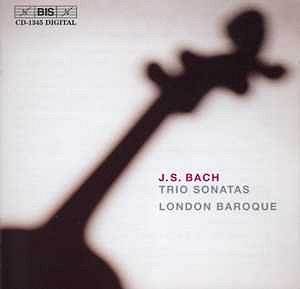Bach’s trio sonatas for organ are among his finest
works. These pearls are small-scale sonatas in three movements, which
feature some of the most delicate counterpoint in all of Bach’s works
(outside his fugues). Written for three ‘voices’, two on the keyboard
and one on the pedals, they offer a vast horizon of carefully-sculpted
melodies.
Unlike many of Bach’s organ works, these are not based
on religious hymns, nor are they as impenetrable as some of his more
complex fugues. These six suites are full of joy and energy, and are,
perhaps, some of the happiest music Bach wrote.
London Baroque presents a new recording of the trio
sonatas arranged (by Richard Gwilt) for their four-member ensemble.
While the notes to this disc spend a great deal of time justifying the
idea of transcribing such works, this defense is no longer necessary.
The music speaks for itself.
From the very first notes on this disc, one can hear
the fine quality of the performance and the energy the musicians infuse
into this recording. The opening movement of the F major sonata is played
with brio and verve, and comes alive at a tempo which may seem surprising
at first (a bit faster than is usual on the organ), but which fits it
perfectly. All of the fast movements in these works feature this energy
and drive, while the slow movements, such as the slightly fugal lento
of the G major sonata, are highly introspective and subtle.
London Baroque play with such a perfect texture that
this music seems to have been written for their ensemble. The balance
among the instruments is almost perfect, and the music comes through
in excellent harmony.
The sound of the ensemble has some minor flaws - a
slightly harsh sounding violin in the C major sonata, especially in
the largo, and the occasional passage that is a bit too dense. But overall,
London Baroque is very close to perfection when they play this delicate
music. One choice that may not be ideal is the use of organ for the
continuo of two of the sonatas and harpsichord for the other four. While
both sound excellent, there is a lack of unity among the works for this
reason. Perhaps if the sonatas alternated between the organ and harpsichord,
or if they all used one or the other, this unity would be more solid.
This fine recording is certainly one of the best Bach
discs of the year. London Baroque confirm their qualities as not only
sensitive and well-balanced, but also creative in these fine transcriptions.
This is an essential recording for Bach lovers, who will find new worlds
of feeling in music that is certainly familiar.
Kirk McElhearn


